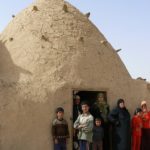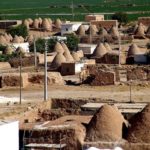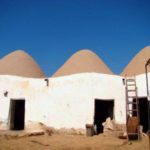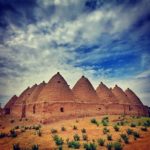These earthen beehive houses have been keeping Syrians naturally cool for centuries.
Built of all natural local materials, the thick walls help naturally cool the interior by keeping out the sun, and acting as a thick insulation for the heat to permeate. The walls are made from mud bricks, stacked in a giant circle. Building height, they close in to a conical shape and capped off by a dome shape.The interior and exterior walls are packed with straw and mud: in the arid desert, the mud walls dry to a hard and durable finish.These domes are effective in hot, dry climates.There are even villages of them located in Aleppo, the largest city in Syria, which has been continually inhabited since the 6th millennium BC. The Aleppo beehive homes are used for both storage and residences.
The top of the beehive dwellings have an oculus—a hole that provides light to the interior and sucks hot air up and out. Even though there is an opening at the top of the dwelling, the conical shape keeps the interior dry during the rare rainy season. The shape also enables rain to quickly drain off of the façade, meaning minimal mud erosion on the exterior of the homes.
The interiors of the beehive homes are very dark, as most are built without windows. Although the darkness can be inconvenient, the windowless walls protect residents from the harsh desert winds, and block out the sun. With these natural heat-beating factors in place, the interior of each home remains around 75-85 degrees Fahrenheit, while the outside desert can blaze up to a blistery 140 degrees!
These eco-friendly beehive houses have been keeping desert dwellers across the Middle East sustainably cool and comfortable for centuries, and continue to do so even now.
The beehive homes also protect their residents from cold temperatures, serving as a strong guard against powerful desert winds and maintaining a comfortable temperature.
Restricted choice of building methods and materials left the north Syrians few alternatives, mostly painful. Their houses had to resist the mechanical stresses of wind pressure and the minor shocks of the frequent earthquakes which afflict the region. Door and window openings had to be few and small to minimize the sun’s glare and the entry of hot air during the day as well as cold air at night. And they had to have a high-heat-capacity roof to absorb the sun’s rays during the day, and slowly reradiate it toward the interior during the cool night; the roof, furthermore, should have a continuous surface to provide a maximum of shade with a minimum of area exposed to the sun, and it should slope steeply to shed the occasional but torrential rains. All this-and it had to be built of the only abundant material locally available: adobe brick.
Its conical shape presents almost no structural difficulties, requires no high-tensile-strength reinforcements, and can be built quickly by unskilled labor. Inside, its high dome serves to collect the hotter air, and outside to shed rainfall instantly, before the brick can absorb it and crumble. Its thick roof-cum-wall is an excellent low-velocity heat-exchanger, and keeps interior temperatures between 85° and 75° F. while outside noon-to-midnight extremes range from 140° to 60°. Nothing cheaper-nor more rugged, more efficient, and easily serviced-can, be built at the same site from local materials. The beehive house, moreover, attains that ideal that architects eternally seek but so seldom find: it combines functionalism with simplicity, elegance and beauty.




